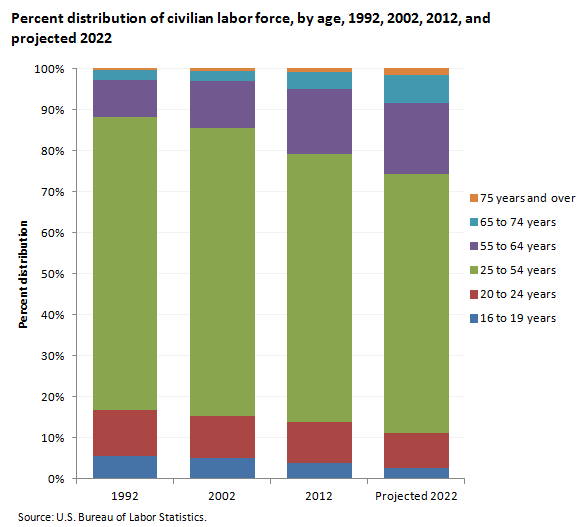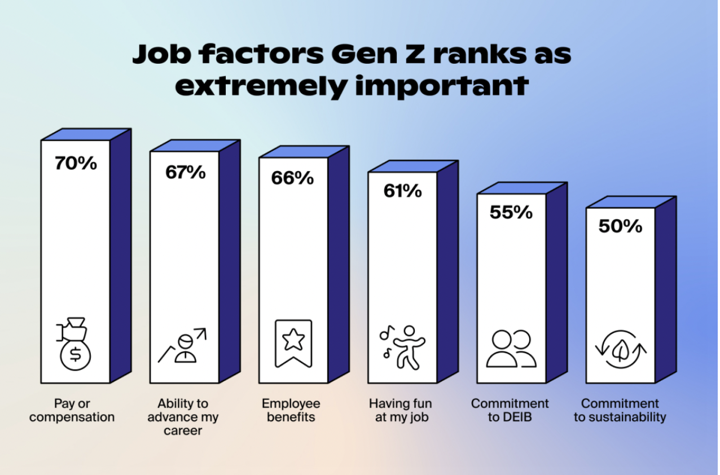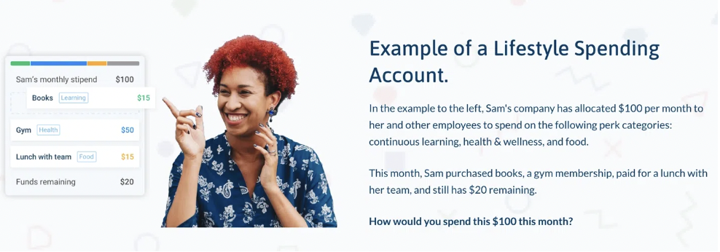by Lauren Schneider

A smart business leader knows that salary alone is not enough to attract and retain top talent today.
And as the lines between work life and personal life continue to blur and top talent becomes harder to find, employees are leveraging their power as individuals and requesting more from their employers.
Employee perks at work are a big part of that request.
A recent industry study reported that 83% of employees weigh innovative employee perks and benefits in their decision to accept a job offer. Those numbers are nothing to scoff at.
If you're looking for research-backed perks that people truly want, we've got the perfect list for you.
Below are the best employee perks that you need to implement to solve for your employees' unique needs:
- Flexibility programs around work location or hours
- Shorter work week
- Sabbatical
- Parental perks
- Mentorship programs
- Coaching services
- Employee perk stipends
- Wellness initiatives
- Student loan assistance
- Commuter benefits
- Out-of-state care stipend
- Peer-to-peer recognition and rewards
- Personal and business travel
- Cell phone reimbursement
Oh, and just so we’re on the same page; we define employee perks as:
The ways to support employees beyond salary and benefits (e.g. insurance, retirement benefits like 401ks), including purchasable perks, programmatic, and environmental perks. Purchasable perks include catered lunches, books, fitness stipends, pet insurance, and student loan forgiveness. Programmatic perks are policy-driven advantages to working at a company such as being pet-friendly, Summer Fridays, or remote work. Environmental are the amenities you offer on-site and even the office set-up to best support your team.
We want you to better solve for all of your employees. That’s why we’ve read every new "best employee perks" article and talked to benefits experts and many employees to curate this detailed list of top employee perks for your employees.
1. Flexibility around work location or hours.
This perk directly aligns with the labor force's move toward increased flexibility.
Recently a study found that 78% of employees say they want location flexibility and nearly all (95%) want schedule flexibility. That’s pretty significant when it comes to employee needs to do their best work. And allowing employees to own their schedule also has tremendous mental health benefits.
Offering more flexibility doesn’t have to be complicated. Creating a program around the types of flexibility and then checking in frequently to see how it's performing is a great start.
First, consider creating flexibility around work location:
- Partially remote work: The company office is their primary headquarters, but they choose the best working location based on the tasks and projects on deck for the week, day, or moment. This could include their favorite local coffee shop, the city’s public library, or their home desk. Since today’s type of work is considered to be more mentally complex than in prior decades, it requires more deep work, collaboration, and continual up-skilling.
- Fully remote work: The opportunity to work not at the local headquarters, and instead work from their home, a coworking space in a different city, or even the road.
Now consider creating flexibility around work schedules and hours.
The professional world can learn something from hourly work, and that is to pick their own work schedules and hours.
A recent survey from Robert Half found 41% of managers allow employees to choose their own working hours. Further, 27% of managers don’t mind if employees put in fewer than 40 hours each week as long as they finish their work. Remote work has pushed more of corporate America to say goodbye to the traditional 9-to-5, as well. Rather, employees are working when they feel most productive.
Below are a few ideas related to work-hour flexibility below:
- TimeShift: Enabling employees to shift their hours to be their most productive selves. Instead of being in the office from 9-5, allow them to change their hours earlier to 7-3 or 11-7 to avoid rush-hour traffic, better accommodate their partner’s schedule, or align with the time when they produce their best work.
- Micro-agility: Empower employees to change their work hours slightly when necessary and make up the hours later, so as to not have to take a limited vacation or sick time. Examples of this include giving employees the freedom to step away from the keyboard to run an errand, attend a doctor’s appointment, or pick up a sick child from school, and then make up that missed time later that evening or another day that week.
- Part-time work: Letting people temporarily or permanently go part-time to better accommodate a new life situation such as being a parent, caring for aging parents, or even wanting to continue their side business.
Ultimately, your focus should not be having “butts-in-seats” during specific hours but instead offering your employees the flexibility and opportunity of delivering their best work from their preferred setting during their preferred time.
2. Shorter work week
While we have been taught to “hustle” and acquire the “no pain” approach, adopting this mindset certainly is not the way to bring out the best in your employees.
It’s not much about working hard but about working smart. Studies have shown that if you keep your leadership team well-rested, and with a great work-life balance program, they will perform at higher levels and be on track for sustainable growth.
If you want to test this idea out, try starting out by experimenting with Summer Fridays (where all of your employees, both in-office and remote take Fridays off during Summer) or read about how this social media company successfully cut back their company to a four-day work-week and saw a spike in employee happiness.
This is a perk especially loved by parents as they're able to spend more time with their children instead of sending them off to daycare or leaving them in the care of a nanny for 40+ hours a week.
3. Sabbatical
Why is this one a hot employee perk? Paying for people to take a month off to explore life is an excellent way to support the whole human.
A sabbatical rewards employees for hard work over an extended period of time (often three or five years) and gives them a likely much-needed break.
Your people are able to use this time however they see fit whether it means traveling, exploring new hobbies, spending time with family, or simply doing nothing for a change.
If this is something you decide to implement, consider encouraging your team to write about their time off on your internal wiki or use a hashtag to highlight their adventures. When employees are given the option to take a sabbatical, it feels like a large investment to an employee. Not to mention, it will pay dividends in your employer brand and retention strategy.
4. Parental Perks
A big reason parental-related perks are becoming a top perk is that millennials are now the largest generation in the workforce.
More than one in three American labor workforce participants are millennials. The age range of millennials today is 23 to 38, with many of them now becoming parents.

In addition to paid parental leave (an urgent necessity), powerful parental perks include Facebook’s $4,000 baby cash perk stipend for new parents, overnight shipping of breastmilk, daycare stipends, maternity concierge services, Spotify’s coverage of fertility treatments, university coaches and support for college admissions, and making your current office perks inclusive.
Here are even more ways to support parents when working from home.
5. Mentorship Programs
Mentorship opportunities and programs inside an organization are fundamentals in the eyes of millennials and Gen Z alike.
In fact, key motivating factors for Gen Z include work-life balance, mentorship, and professional development. To them, these offerings are just as important as fair pay and health care.

Additionally, Handshake found 71% of survey respondents expect to be promoted between 6 months to 1.5 years, doubling down on Gen Z’s reputation of being entrepreneurial and their search for a sense of ownership.
These numbers shouldn't be surprising. People entering today's workforce are facing a more complex work environment than any generation before. Entry-level roles today are forced to wrangle deep data, code complex problems, and communicate more complicated programs via more channels. Work is more cognitive and non-routine, and mentorship opportunities support these team members in being successful.
There are other benefits too. As an Insperity article (linked below) points out:
"Mentoring can also be more effective than formal training, which is often built as a one-size-fits-all solution for any business. Unlike formal training courses, mentoring often results in much deeper, personalized conversations and feedback."
Ready to develop a company mentoring program? Here are some resources to get you started:
- How to Build A Successful Employee Mentoring Program (Insperity)
- How to Start A Corporate Mentoring Program
6. Coaching Services
In previous years, coaching became one of the hotter perks, and we expect this trend to continue into 2023. Similarly aligned with the reasons above mentioned in mentorship, they help team members to learn the skills they need to succeed in an ever-evolving workplace.
People often will question coaching as it is an expensive way to support employees but the benefits of coaching are significant:
- 80% of people who receive coaching report increased self-confidence.
- More than 70% of people who receive coaching experience improved work performance and relationships, as well as more effective communication skills.
- A Metrix Global study found that executive coaching has a 788% return on investment (ROI) when measuring factors like increased productivity and employee retention.
If you're interested in getting coaches for your team, consider the following companies:
7. Employee perk stipends
All of the purchasable perks you already offer your employees likely benefit a subset of your employees. But that’s just it, they only benefit some employees not everyone.
However, with Perk Stipends (also known as lifestyle spending accounts or perk allowances), a company doesn’t have to decide between supporting mental health, people with student debt, parents' needs, or pet lovers. With a stipend, an organization can support all of its employees’ needs regardless of location, age, life stage, and more.
Employees love them because they're flexible and put them in control of their own benefits, and people leaders love them because they lighten their administrative load, track usage, are IRS compliant, and are also excellent for employer branding strategies.

Get started with a perk stipend:
- The Definitive Guide to Employee Perk Stipends
- Health & Wellness
- Learning & Development
- Remote Work Stipends
- See how much you could save by switching to a perk stipend
8. Employee Wellness Initiatives
The main selling point of every good wellness program is that it has the power to lead to meaningful behavior change.
In the past several years, the meaning of "wellness" has transformed into something of much greater scope. People used to define wellness as gym memberships and the creation of on-site workout spaces. But now, wellness is used in a personalized way. It now represents a healthy diet and exercise program, focus on mental health support, mindfulness, sleep, stress management, financial wellness, or cultural and leadership behaviors within the organization.
This employee perk can have a trickle-down impact on your employees. As they feel better, they're likely to contribute more and better work.
This is especially important given our current times. As mental health advocate and policy advisor Poppy Jaman of the MindFoward Alliance recently said in a McKinsey Health Institute interview:
“Over the last decade, leaders from all around the world have asked how to make mental health a business goal and include it on the boardroom agenda. But few have had the courage to set in motion a strategy that would last beyond their tenure. Mental health is not an issue that is going to end within their careers, so the current climate of “short-termism” has been a real barrier."
"Our focus needs to be on creating workplaces where humans can flourish. If we’re not taking care of people, then what are we doing?”
And health and wellness initiatives do not have to be constrained to on-site gyms or local fitness classes. The opportunity to allow your employees to personalize their meaning of wellness can be in the form of reimbursing a subscription to their favorite meditation app or encouraging healthy eating by creating a Slack channel where people post their favorite recipes.
Wellness programs are also known to reduce healthcare costs, increase productivity, and help build and sustain high employee morale.
9. Student Loan Assistance
Some companies are all about this perk that they denominate it as “the hottest employee benefit.” To attract and retain recent graduates, smart companies are helping to reduce student loan debt for their talent.
To put things into perspective, about 45 million Americans have student loan debt; that’s about 1 in 7 people. The average debt amount hovers around $30,000.
One of the most desirable opportunities of adopting this employee perk is increased employee loyalty among your younger team members, usually the ones saddled with big student loan debt.
10. Commuter benefits
A great way to make commuting more accessible and incentivize a return to office is with a commuter or gas stipend.
A gas stipend is a specified allotment a company offers employees either monthly, quarterly, or annually to cover the cost of fuel. Organizations may instead offer a general commuter stipend, which would provide a fixed amount of money that employees could use monthly to cover (in addition to gas) vehicle maintenance or public transportation costs (bus fees, train tickets, etc.).
A report from Clever Real Estate revealed commuters in the United States spend around $8,466 commuting each year. That amounts to 19% of their annual income. The report also showed the average yearly spend on fuel is $867 with an additional $410 spent on vehicle maintenance.
Offering a commuter stipend is also a great way to encourage employees to utilize public transit or carpool, a benefit for not just employees but the environment, too. The passenger car is largely responsible for why the transportation sector is #1 for greenhouse gas emissions in the US. It’s also responsible for 25% of emissions in the world.

11. Out-of-state care stipend
Traditional health benefits only offer so much support. Supplement insurance with an out-of-state care stipend for those who may need to travel for specialty treatment. The expectation is that medical procedures will first be covered by health insurance. This stipend covers tangential expenses.
An annual stipend put in place for every employee to access if or when they need it for out-of-state medical expenses could satisfy fertility needs, pay for specialty cancer treatments, or help with prosthetics expenses. It can also be used toward things like childcare costs incurred while receiving such care.
This stipend is intended to be used when an employee cannot get the care they need in their current state and, therefore, must travel to receive such care. We offer this stipend at Compt and, as part of our program, we do not require anyone to disclose what their medical needs are. This stipend is given on the honor system.
12. Peer-to-peer recognition and rewards
What better way to reward your team for a job well done than a little gift? Peer-to-peer recognition adds a personal touch to make your people feel seen, heard, and valued.
In a recent SHRM and Workhuman Employee Recognition survey, 68% of organizations with a recognition program reported a direct positive impact on employee retention.
These spot bonuses don’t have to be reserved for project wins, though. Recognition can happen throughout the year with birthday bonuses, anniversary bonuses, sales incentives, or general rewards for a job well done – whatever it might be!
Take your rewards and recognition stipend to the next level by integrating it with your company’s communication platform like Slack. Every time a bonus is given, a notification can pop up in a dedicated Slack channel so you can share the great news with the whole team. Sharing the love doesn’t have to be limited to spot bonuses. Team members can also share how they’re spending other stipends through Slack. When you offer stipends through Compt, for example, you can create a designated #HowICompt channel to see how engaged your employees are with their lifestyle benefits and double down on your company culture.

13. Personal and business travel
A company culture commitment to work-life balance means ensuring employees don’t squander valuable time off and travel opportunities. Making sure people actually use their PTO helps avoid burnout; encourage your team to take time away from the office (even if it’s virtual) by offering personal travel reimbursement.
Common expenses covered with a travel stipend include:
- Airplane tickets
- Bus tickets
- Dining allowance
- Fuel for road trips or a rental car
- International data plan
- Luggage and packing
- Passport fees
- Pre-paid phone card
- Travel applications
- Vacation activities
Offering enough vacation time and encouraging employees to rest and recharge benefits everyone, team and company alike. When employees feel fully supported, they take fewer sick days, file fewer workers’ compensation claims, use fewer healthcare benefits (because they’re healthier!), they have more energy and motivation, report higher job satisfaction, and they’re overall more productive.
These 10 companies have seen astounding results from offering travel benefits and employees have been able to go on life-changing trips. For example, FullContact, which offers unlimited PTO, 26 company holidays, and a vacation stipend ranging from $2,000 to a $7,000 cap depending on tenure, boasts an 85% retention rate.
Not every company can offer such a significant amount, but even a small stipend shows that you’re thinking about your employees in meaningful ways that go beyond the basics.
14. Cell phone reimbursement
Is your team using their personal cell phone for work-related email? Even if they’re messaging on the work Slack or Microsoft Teams channels, social apps, or responding to work texts, you need to offer cell phone reimbursement.
Cell phone stipends are non-taxable benefits, so they’re great for companies and employees alike.
The 2022 Maximizing Mobile Value study found 98% of organizations offer a full or partial stipend to cover BYOD (bring your own device) policies. Most offer $30 to $50 each month which makes sense for employees paying monthly phone bills, but companies can also choose to offer a quarterly stipend. Quarterly stipends are the more popular choice when a “work perk” program is in place rather than a specific cell phone reimbursement stipend.
The average company spends $482 annually per employee with mobile stipends. This perk is an affordable way to help employees pay bills, taking a little bit of stress off their shoulders.
Those are the top perks for 2023. We'd love to hear from you. Reach out to us on Twitter and LinkedIn or email us to let us know what perks you'd love to add to your total rewards package or which fringe benefits your team has found the most success with.
Compt is the #1 employee stipends platform that gives your people the freedom to choose the lifestyle perks that are best for them and their always-evolving needs, even when remote. Interested in learning how Compt might benefit your company? Consult with our team or request a demo.
